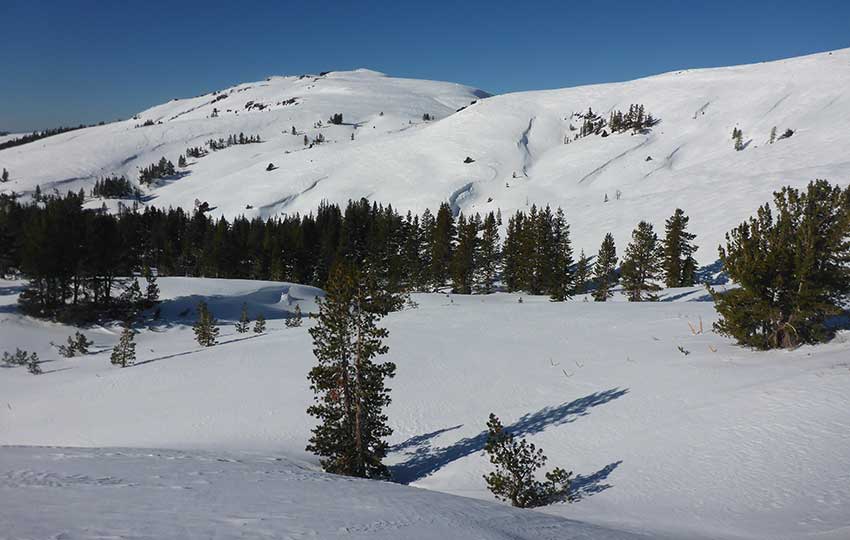
This article featuring frequently asked questions about classic cross-country ski gear is a “greatest hits” list I’ve compiled about classic xc ski gear. I’ve been asked these questions (and more) frequently enough to warrant collecting them in one convenient article.
Please note, however, that the answers I provide are succinct and abridged. Like any art, the gear and technique of classic cross-country skiing form an integrated whole.
So, although the answers I provide here are accurate they don’t necessarily show you the whole picture.
Support Tahoe Trail Guide with a financial contribution via PayPal (single contribution) or Patreon (reoccurring contributions). Your support of Tahoe Trail Guide is very much appreciated!

If you want a greater understanding of the subjects in question, read my other articles in the Cross-Country Skiing Explained series. And, be sure to consult other resources regarding classic cross-country skiing.
Lastly, this list of questions regarding classic cross-country skiing is focused on actual gear. If you’re looking for information about waxing your waxless cross-country skis, read FAQs about Waxing Your Waxless Cross-Country Skis and Waxing Your Waxless Cross-Country Skis: Introduction.
Please note that this article is a work-in-progress. I’ll add relevant questions and answers as they arise.
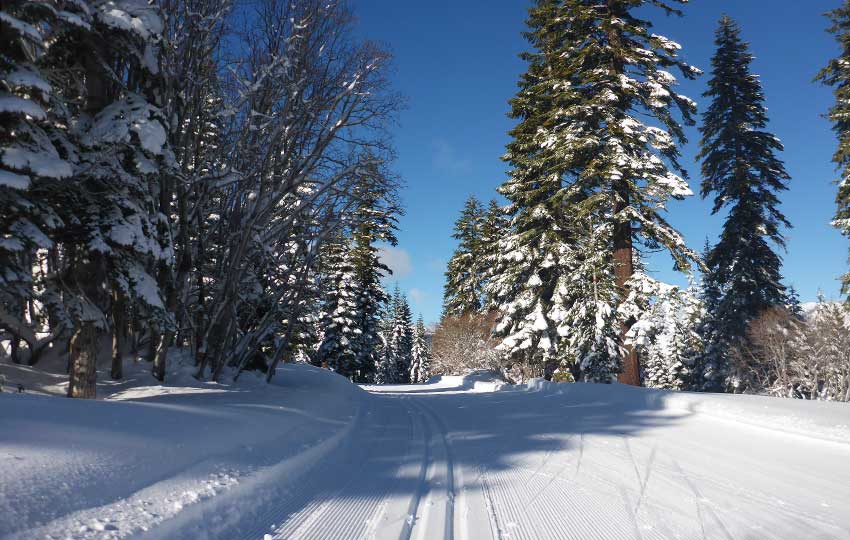
What length of classic cross-country skis should I use? How long should my classic cross-country ski be for my height?
The proper length of your classic cross-country skis is primarily based on your body weight. This weight should also include the clothing and gear you’ll be carrying while you ski.
Every model of ski and ski length made by every cross-country ski manufacturer will have its own unique weight recommendation. Therefore, you can’t assume that one size will meet all of your needs or be the same for every ski appropriate for you.
For example, I run 179 cm skis in the off-track/backcountry variety, but use a 192-196 cm classic track ski.
Your ski length can also be influenced by your height. However, this is really only if you’re exceptionally tall and thin or short and rotund.
For example, too short of a ski for a very tall person and too long of a ski for a very short person will negatively affect either person’s technique.
For more information, read Cross-Country Skiing Explained (Part 2): Geometry of Classic Cross-Country Skis.
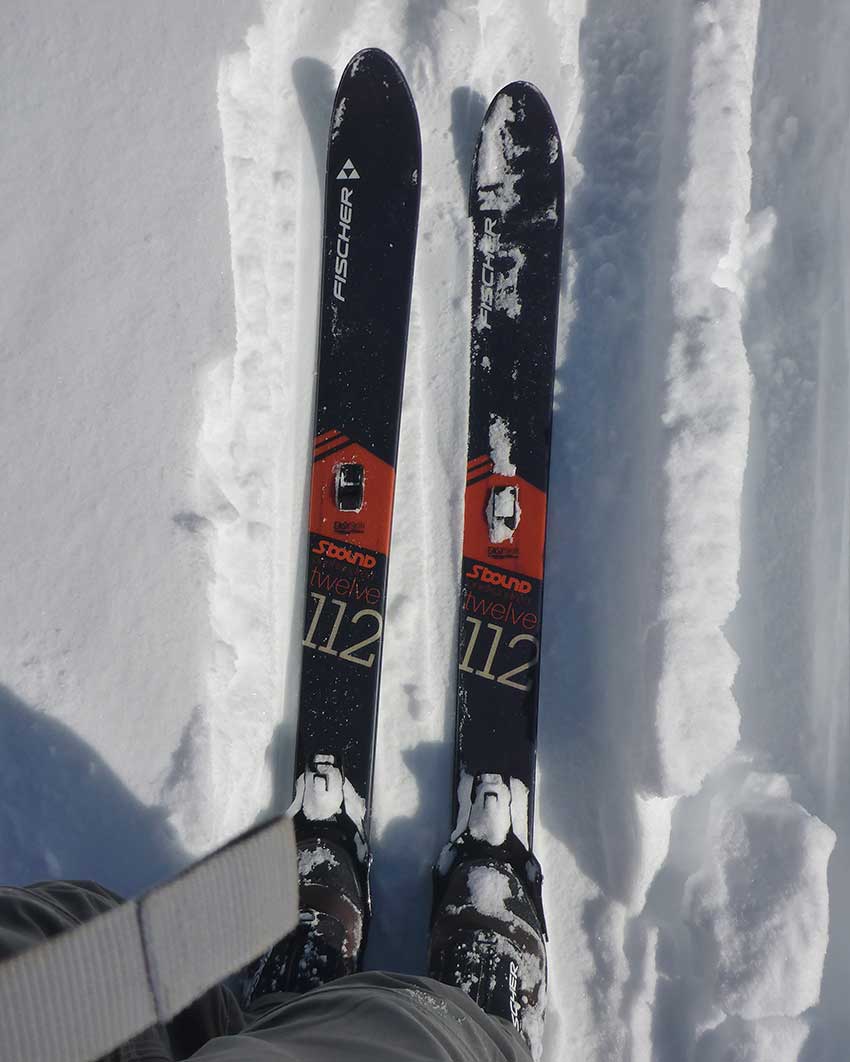
How long should my classic cross-country ski poles be?
Generally, I recommend using classic cross-country ski poles that come up to the middle of your shoulder. Stand the pole upright next to you. Where the ski pole strap exits the ski pole grip should measure to a height somewhere between your armpit and the top of your shoulder.
The official measurement, according to World Cup standards, is 83% of your height in centimeters.
Also note that five centimeters in length difference, whether a little shorter or taller, is not a big deal. My preferred length of classic xc ski pole is 140 cm. However, I could use either a 135 or 145 cm length ski pole and be just fine. I’ll have to adjust my hand position (as it holds the ski pole) in those alternate sizes, but I could do it relatively easy.
For more information, read Cross-Country Skiing Explained (Part 6): Classic Cross-Country Ski Poles.
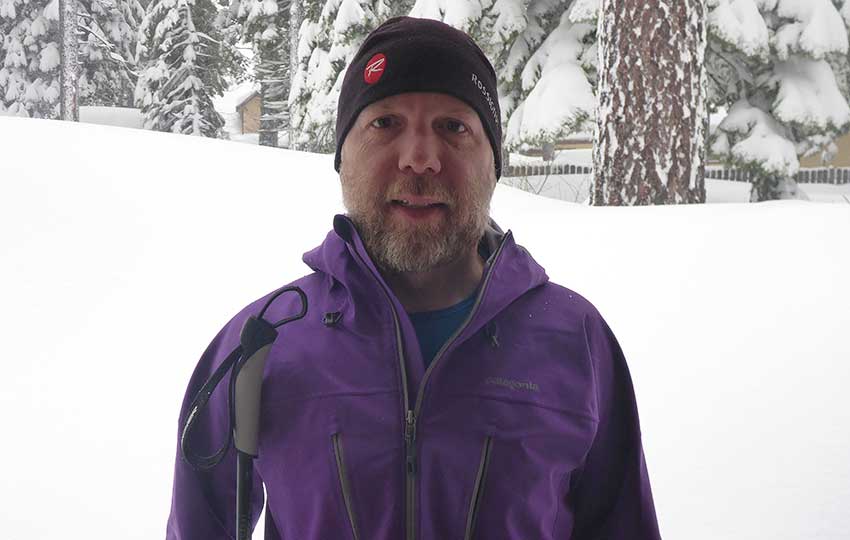
Why are classic cross-country ski poles so tall? Why are xc ski poles so much taller than downhill ski poles?
Classic cross-country ski poles are designed to provide a means of propulsion and forward movement. Although they can help with balance, they’re primarily used to help you go forward faster.
In order to provide seamless propulsion, classic xc ski poles should enable you to swing your arms as you’re skiing in a natural fashion. Your arms should have a slight bend in them as they swing from the shoulder.
Angle your hands in a way that the ski pole tips land, while skiing, at your foot or behind your foot.
For the average cross-country skier (i.e. not a World Cup competitor), your ski pole tips should never land in front of your feet.
If classic xc ski poles were significantly shorter than 83% of your height, you’d be hunched over uncomfortably while trying to use them as designed.
If the classic xc poles were much longer than 83%, you’d end up angling the ski poles nearly parallel to the ground. This would cause the tips to plant at too shallow of an angle to provide any real bite into the snow.
For more information, read Cross-Country Skiing Explained (Part 6): Classic Cross-Country Ski Poles.
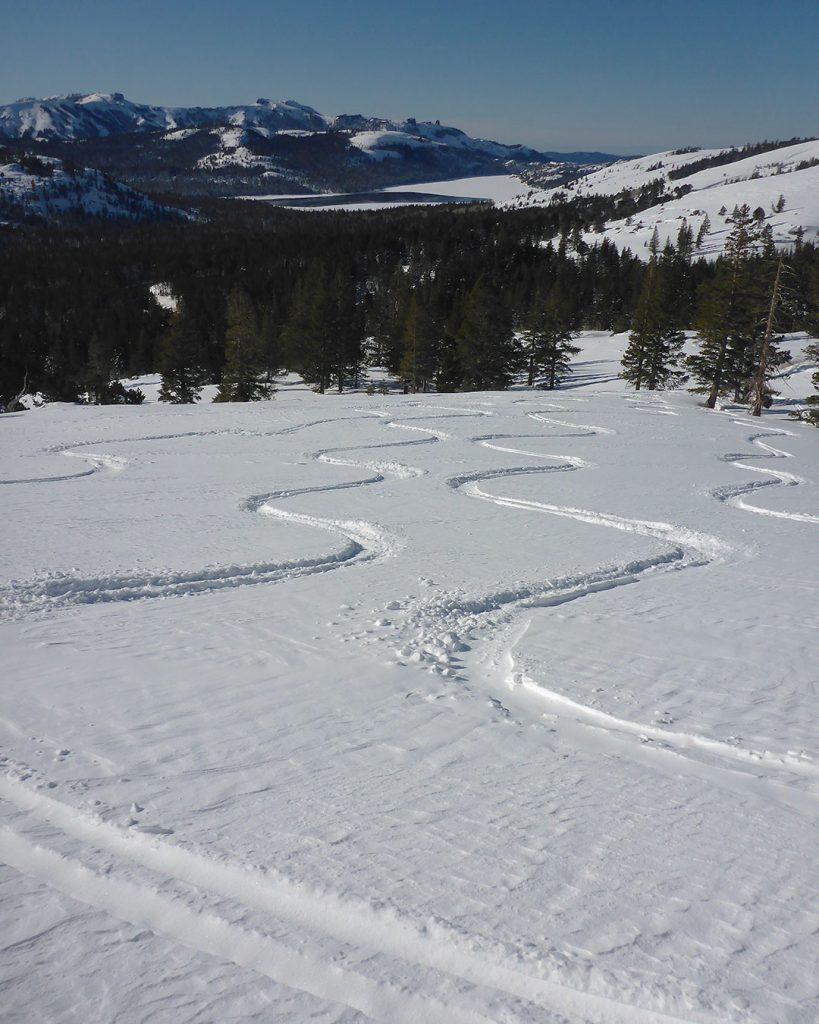
Should I buy used or new classic cross-country ski gear if I’m new to xc skiing?
This is the age old question whenever diving into any new endeavor. And it’s usually followed up with…
- How much should my initial investment be?
- What if I don’t like it?
- Will my enjoyment and performance be directly based on how good my gear is?
I seldom recommend to beginners that they buy used cross-country ski equipment. The reason for this is that there are a ton of binding systems out there that are not compatible with the many different styles of xc ski boots available.
You may find a great set of skis with bindings already mounted. However, you may then find yourself wasting a lot of time trying to find a compatible boot for the binding system. And then, occasionally the brand of boot that is compatible with the binding system on your new old skis features a foot mold not compatible with the shape of your foot.
A problem with buying used xc skis is that every model and length of ski manufactured has its own specific weight recommendation. As a beginner, though, how will you determine whether or not those skis are appropriate for your size?
I’ve met many people who have purchased used equipment only to end up using it as decoration for their storage shed or garage. Again, this isn’t to say that you couldn’t find a great deal that would be appropriate for you. I’m just saying that without knowing what it is that you need, your whole buying experience can just be a shot in the dark.
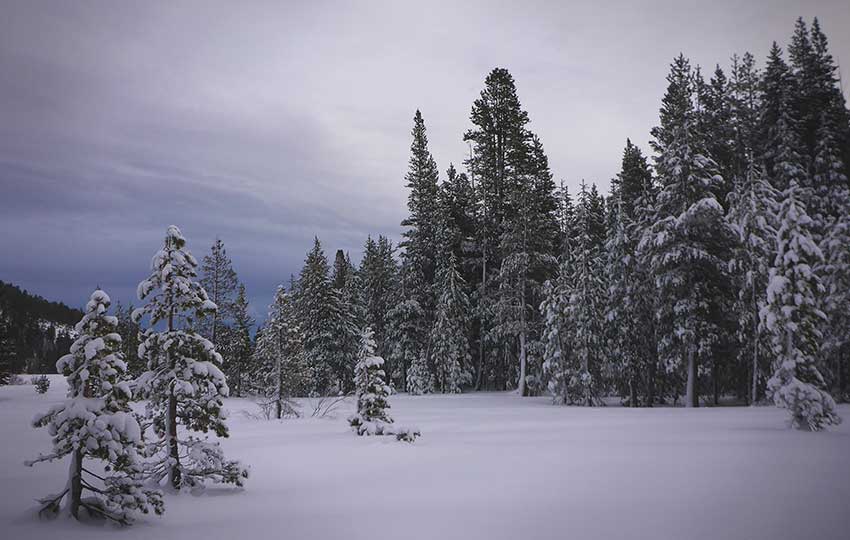
On top of everything, that great used gear you buy may be hiding significant wear and damage. It can be hard to tell how much damage gear has occurred in its previous life.
Experienced skiers have a better chance of identifying appropriate gear for themselves. Even then, though, I’ve known some experts to have acquired used gear that didn’t work out in the end.
For more info, read Buying Cross-Country Ski Gear, for Beginners (Part 1).
Can I buy one set of classic cross-country skis to use both on groomed terrain and in the backcountry?
This is the age-old question of all skiers.
Why can’t I just have one set of skis to do everything?
Well, the answer is the same as if you asked whether or not you could use a hammer to cut sheet metal and a pair of tin snips to hammer nails. Two different tools for two different jobs.
Technically, however, you could buy one set of skis and make them do everything. However, you wouldn’t have a great time in any one snowy condition. Now, this isn’t to say that you have to buy a dozen different sets of cross-country skis (although, that’s really easy to do!). But, if you plan to ski in both groomed and ungroomed terrain, I recommend buying at least two sets of skis (one for each environment) so that you’ll be able to reap benefits from both worlds.
The problem with trying to make one set of xc skis accommodate groomed tracks (like you’d find at a groomed xc ski resort/area) and backcountry conditions is that groomed tracks are only about 70mm wide. This means that if you want to classic ski in the tracks at a groomed xc ski area, you need a ski that’s skinnier than 70mm. Realistically, though, I don’t recommend anything more than 60mm for groomed terrain because the skis will often pinch on the turns. And, anything less than 70mm is just not going to handle snow in the backcountry that’s deeper than a couple of inches.
Watch this video that I produced for more information about this common question.
Why is there a groove down the center of the bases of my classic cross-country skis?
Most classic cross-country skis feature a single groove down the base of the skis. Some have multiple grooves.
The purpose of the groove(s) is to help the ski track straight.
When pressure is placed on the ski from your body weight, snow is forced into that groove. This creates a ridge that the ski will ride along.
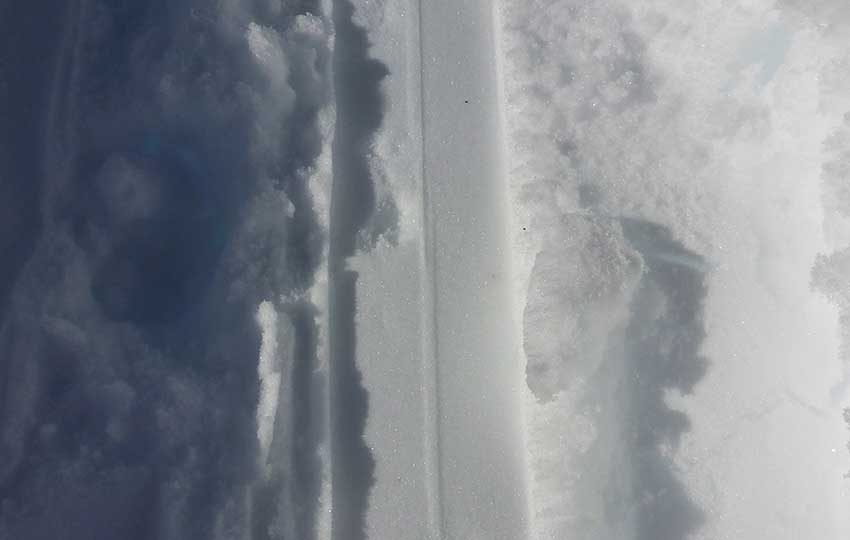
The concept is similar to that of a keel of a boat. Obviously, though, they are inverse shaped structures. Keep in mind, however, that by enabling your ski to track straighter, it does make it slightly more challenging to turn on the downhill.
For more information, read Cross-Country Skiing Explained (Part 3): The Grip Zone of Classic Cross-Country Skis.
Cross-Country Skiing Explained Articles and Videos
Please note that I wrote and produced the Cross-Country Skiing Explained series of articles and videos with the beginner and intermediate cross-country skier in mind. This is the demographic for whom I most often serve(d) while working in the outdoor recreation industry at Lake Tahoe. I basically treat these articles and videos as extensions of the conversations that I have (had) with those customers.
That said, expert skiers probably could take away something of value from these resources. Just know that I don’t address race-oriented philosophy, technique, or gear selection.
Considerations for buying cross-country ski gear (new and beginner xc skiers)
- Intention, Types of XC Skis, and Whether to Buy New or Used (Part 1)
- How Much Gear to Acquire, Evaluate Your Commitment, Value of Taking XC Ski Lessons (Part 2)
- Can One Set of Classic Cross-Country Skis Work for Groomed and Off-Track XC Skiing? (Part 3)
- Can I Use One Set of XC Ski Boots for All of My Cross-Country Skiing Needs? (Part 4)
- Overview of Off-Track and Backcountry Cross-Country Ski Gear
- Invest in Technique More than Gear
Classic Cross-Country Ski Components
- Introduction to Classic Cross-Country Skis (Part 1)
- Geometry of Classic Cross-Country Skis (Part 2)
- The Grip Zone of Classic Cross-Country Skis (Part 3)
- Types of Bindings for Classic Cross-Country Skiing (Part 4)
- Ski Boots for Classic Cross-Country Skiing (Part 5)
- Classic Cross-Country Ski Poles (Part 6)
- FAQs about Classic Cross-Country Skiing
Waxing Your “Waxless” Cross-Country Skis (for beginner and intermediate xc skiers)
- Introduction to Waxing Your Waxless XC Skis
- Step-by-Step Waxing Tutorial
- FAQs About Waxing Your Waxless XC Skis
Cross-Country Skiing Techniques, Demonstrations, and Related Concepts
- Outdoor VLOG (emphasis on the cross-country skiing experience)
- Cross-Country Skiing in Challenging Conditions
- Considerations for Winter Adventure in Lake Tahoe’s Backcountry
- Using the Side-Step and Herringbone Techniques in the Backcountry
- 10 Tips for Spring Cross-Country Skiing in the Backcountry
- 5 Reasons to Love Spring Cross-Country Skiing
- Considerations for Cross-Country Skiing During the Fall and Early Winter
- Discussing the Goal of Becoming a Better Cross-Country Skier and Embracing Backcountry and Groomed Terrain in Pursuit of that Goal
- The Cross-Country Skiing Experience: Immersing Yourself in Winter
Silvia: “How should I measure the pole length? with or without the ski boots?”
In cross-country skiing competitions the maximum allowed pole length is measured with boots on and it is set to 83 % of one’s body height. This formula corresponds well to the older recommendation of 85 % without ski boots, so since you are 166 cm tall I think you should have 166 x 0,85 = 141,1 cm long poles which would make a 140 cm pole alright if you do not want to cut a longer pole to that exact length. A pair of 145 cm poles would probably feel to long for diagonal striding.
Thanks again, Magnus. Yeah, I think the 140cm would probably be the best option.
Hope you’re doing well!
Thanks, Jared. Winter has finally hit southern Sweden so the ski season has begun here too.
Best wishes,
Magnus
Excellent! Glad to hear you have some snow now. Tahoe had some early season snow that’s lasted pretty well, but we’ve been in a slump for the past few month. Hoping for more!
Take care!
Jared
Hi, I have a question. I recently learned how to cross-country ski (only in 2020) and tested the Fischer Twin Skin Carbon Pro classic skis for over a week with Carbonlite Fischer boots. I am not an advanced skier but I can XC ski and enjoy it quite a lot (4 hours per day during the ski-week). I have been reading a lot about how someone should purchase the type of XC skis depending on their skills. What if my current level is intermediate and I purchase this same set of skis (which are for racers) I tested for a week? To be honest, I enjoyed them a lot and the boots were not hurting me. I intend to improve my XC ski technique over the next years. I appreciated that these skis were lightweight together with the boots. Does this type of investment make sense? I would appreciate your feedback.
Hey Silvia,
Thanks so much for the question!
It sounds like you could probably go ahead and purchase that same setup that you had been using (Fischer Twin Skin Carbon Pro). If you were having good success with it, I’d probably just stick with that. And the skis are high-end enough that you’ll be able to grow into them as your technique develops. I don’t really see any sense in trying to find something else since you already liked that set of skis/boots.
But it would eventually be good if you had a lower to mid-range set of skis to use as “rock” skis during the early/end of season. The problem with having only one set of expensive skis is that you’ll wind up putting them through a lot of potentially damaging terrain (assuming you’ll continue to ski as often as you have been). This will be particularly key when you’re dealing with lower snow years and coverage is thin.
Anyway, that’s about all I can think of at the moment. Thanks again for the comment 🙂
Thank you very much for your reply!
You’re welcome 🙂
Jared, could I ask you further questions, please?:
1. Is there a “correct” way to hold the XC skis and the poles when one is walking / carrying them ? I have seen many ways of carrying these (e.g. holding one ski and one pole in each hand horizontally, or vertically; both skis facing each other in one hand and the other hand holding the poles, also horizontally and vertically; someone also carried the skis on one shoulder?!?) I am asking this question because I don’t want to damage my skis and also not look like a fool when carrying them. (Sometimes you see people that carry their alpine skis the wrong way on their shoulders, for instance it should be carried below the ski binding and not in the middle)
2. How should I measure the pole length? with or without the ski boots? I would say the heel of the boot 3-4 cm height. I am 166cm without boots. Depending if I add those extra 4 cm, my pole size should be 140cm or 145cm.
3. In terms of material, I read your article and decided I would like to have a composite / carbon material rather than 100% carbon due to its higher chances of breakability. The point is which material type of pole should I go for if: I am not very strong in my upper body, and I want to avoid getting tired too soon?
Thank you very much for your time answering me!
Silvia
Hey Sylvia,
1) I don’t think there’s quite the same type of goofiness to cross-country skiing compared to alpine skiing with regard to carrying around your skis. Use some ski holders (little sleeve type things that go on the tips and tails of your skis that keep your skis together) and then just carry them as you see fit. I usually just carry mine in the middle (only actually grabbing one ski). Obviously be mindful of the tips and tails so that you don’t shut either end in your car door or the door to the lodge, for example.
2) As far as length of classic ski poles go, shoot for 83% of your height in centimeters. At 166cm tall, you’ll be in-between 135cm and 140cm poles. I’m about 167cm tall and use 140cm classic ski poles. I think you’d be fine with either length (135 or 140). You could always get your poles cut to a specific length, but I don’t think I’d worry about a centimeter or two. Not until you start competing in World Cup races 🙂
3) I think a composite ski pole would be fine. Honestly, you’re going to end up owning about 10 sets of ski poles before all is set and done 🙂 Aluminum are the most durable but the heaviest. And carbon are the lightest, but most costly to replace. A composite pole will be right in the middle of that spectrum. And a lot of times, they’ll have the better custom straps (versus basic loops of aluminum poles).
Sounds like you’re planning for the long-haul, which I applaud. The only real advice I can offer is to not get too invested in getting everything right, right now. You’re going to change and evolve as your technique and needs evolve. If you’re going to invest in anything, I’d recommend getting into some private lessons and/or if there are any ski groups/multi-day lesson type experiences. You’ll get the most out of cross-country skiing by learning technique from quality instructors.
Hope that helps. Let me know if you have more questions 🙂
Thank you Jared ! I appreciate all your guidance.
I checked your video: XC Skiing Explained: How to Choose the Proper Length of Classic Cross-Country Skis (for beginners) but did not find the answer for the distinction of Soft, Medium and Stiff.
I got the 192cm Soft version for Twin Skin Carbon Pro and my weight is 57 kg. The pair I rented were 187 cm / medium. The sales person mentioned to me that it is right for me based on my weight. At the same time, I checked online the ski size chart for Fischer and the range of body weight 55-59kg corresponds to 192cm Soft or Medium. What if I put on weight and I am at 60 kg, then for this weight the ski chart says 192cm – Medium. Would that mean that I am limited with my skis and cannot exceed 59 kg of body weight, otherwise I would be too heavy on the skis and would not glide as easier?
I am starting to wonder that the correct skis for me were 192 cm – Medium…. and not in Soft 🙁
Hey Silvia,
You’re welcome. Glad I could be of service 🙂
I didn’t include information regarding camber stiffness in my video (soft, medium, stiff, extra stiff) because most people looking at my site and channel are in the market for beginner-intermediate gear. Skis that feature different camber stiffnesses are generally of the higher end variety and lean toward high performance/race applications. Also as you venture a bit further up the ladder in quality, the weight ranges tend to be a bit more narrow/specific.
That said, I suspect that you’ll be fine on the 192 soft. I’m actually anywhere between 65-70kgs and consistently run a 192cm classic ski. And I have no idea what the camber stiffness is on any of my skis. haha.
As is, it sounds like you’ll be right in the middle of the weight range for that specific ski. So hopefully if you do, for whatever reason, put on a couple of extra pounds you’ll be fine. I also wonder if the weight range isn’t slightly broader in reality. I’d have to actually see the chart. Better yet, I’d love to see the sticker on the actual ski, because higher end Fischer xc skis come with either a sticker or stamp on the skis with the more detailed information (as opposed to the charts that account for all the skis and weight ranges). The bottom line is that it’s always challenging, when dealing with such subtle variances on paper, to know if the ski is right for you until you actually run the ski on snow. Also know that you’ll most likely have some type of binding plate on the skis with the option to adjust the bindings fore/aft. If that’s the case, and you do find that your skis aren’t gliding enough, you could always move the binding back a click or two. But if those skis wind up being too stiff for you, even by moving the binding a click or two forward, you may never actually get any grip.
Anyway, if you’ve already ordered the skis (192 soft) I don’t know that I’d spend a whole lot of time second guessing yourself at this point. I realize it’s a big purchase, but you’ve done the research and everything sounds reasonable on paper. Besides, if you’re as committed to xc skiing as it sounds like you are just know that these will not be the only pair of skis you’ll ever buy. For example, I’ve managed to accumulate 10 pairs of various lengths and styles of xc skis in the past few years!
Thanks Jared ! I will let you know about my experience with the new skis soon 🙂
Awesome ?
“Your ski length can also be influenced by your height.”
Traditionally, your height was the main decider of your ski length, and I think it should be, even today. Just like with ski poles there was and is a formula for the length of classic cross-country skis: Height x 115 %. For a skier 180 cm tall, 207 cm long skis are appropriate.
Very cool! I was not aware of the formula for the classic ski. Sounds generally about right, though. I’m 167 cm tall and use for my main pair of classic skis a 192 cm ski.
But since skis are currently manufactured to various flex ratings (soft, medium, stiff, and extra stiff), I would argue that the weight recommendations would take precedence. And there’s also the trend of creating standardized sizes of non-race skis that accommodate wider weight ranges but are generally shorter than a traditional track/race ski. Most of the off-track/backcountry skis made only come in 3 sizes (approximately 169, 179, and 189 cm). Although they are slightly different, I’d still consider them a classic ski as they have a grip zone and significant camber to allow for diagonal striding.
Yes, this is interesting because there are also formulas (or formulae, if you want to speak Latin) for the length of skate skis and poles and these are “height x 110 %” and “height x 90 %” respectively, so the formulas for classic skiing is 15 % up or down from body height and 10 % up or down for skate skiing.
I assume you meant 166 cm, Jared, which gives 166 x 115 % = 190.9 cm ski length, so 192 cm is a fitting length for your classic skis.
I think both length and flex rating are important, but of course: if your classic style skis are correct in length but you totally compress the camber on them all the time, or never, they are not of much use unless they have e.g. Optigrip bases.
The lesser lenghts of backcountry skis are there mainly for making them more easily turnable, I believe, and although one can use them for diagonal striding they are not really cross-country skis for groomed trails.
Haha. Yeah, 66 inches – 167 cm 🙂
Interesting about the ratios for both styles of skiing. Fairly easy to determine the proper length based on those numbers! I’ll eventually work those into the actual article.
The off-track types of skis are definitely shorter to make them more manageable when turning and navigating terrain features. It’s funny, though, because I see a lot of customers who believe the wider ski with metal edges will make them more stable on the groomed trails. I find it’s just the opposite. The width of those off-track skis in addition to their more pronounced sidecut make them super frustrating to work with on firm and flat terrain. They just skid around a lot and don’t want to track very straight.
Ha, ha! OK, 167 cm which gives 167 x 115 % = 192.05, so your classic style skis are indeed the correct length!